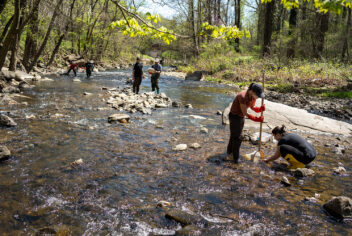In the United States, abuse is all too real. Every day, far too many people experience the trauma of abuse in their lives and the negative effect that it can have on every other facet of life.
For people attempting to escape an abusive situation, their local abuse prevention nonprofit is a critical source of support, connecting survivors with things like housing, community, food, clothing, counseling, and more — all with the goal of helping them regain control of their lives.
Whether it’s for survivors of spousal abuse, elder abuse, or child abuse, there are many different types of abuse prevention organizations, each with their own set of programs and services. As a result, each abuse prevention organization has different needs from their insurance.
What are some of the most important considerations that abuse prevention organizations have when it comes to their insurance? Let’s ask them!
NIA insures hundreds of these types of organizations, and over a number of them shared their thoughts below.
What do abuse prevention organizations need most from their insurance?
Nonprofit focus and specialization:
Lisa Fraser, Executive Director of the Center for Family Strengthening, says that the most important factor in selecting an insurer was “nonprofit focus.”
The Center for Family Strengthening serves as the designated Child Abuse Prevention Council of San Luis Obispo County, CA — the entity responsible for local efforts to advocate for proven primary and secondary prevention services protecting children from maltreatment and neglect.
Elayne Holder is the Resource Development Director at the Folsom Cordova Community Partnership in Rancho Cordova, CA, also cited a specialization in nonprofit services as key to their insurance needs: “We like that NIA understands the needs of nonprofits and together we have built a relationship that supports our nonprofit.”
The Folsom Cordova Community Partnership’s mission is to strengthen families through vital services like rental and electrical assistance, food, clothing and diapers, and education programs that include home visitation, parenting classes, youth programs, refugee services and a job center.
“The most important factor in choosing NIA was NIA’s dedication to nonprofits,” said Marshall Hamilton, interim executive director of SAFE Family Justice Centers in Riverside County CA.
SAFE Family Justice Centers provides a collaborative, trauma-informed space where survivors of abuse and violence can access a network of resources, including legal support, counseling, and youth programs.
“NIA’s deep understanding of the risks and challenges we face, combined with their customizable policies, ensured we had coverage that matched our mission and operations,” Hamilton said.
Orlene Grant is the founder and CEO of the Juanita C. Grant Foundation in Prince George’s County, MD. Their mission is to improve the lives of older adults through direct services and solution-based programs to older adults in diverse and marginalized communities.
Grant mentioned the most important factors in choosing insurance for the foundation were cost, breath of coverage, resources, and good service.
“NIA is a great company that is providing a critical service to nonprofits throughout the country,” she said. “Without NIA coverage, it would have been difficult to find comparable coverage, resources, and service at an affordable rate for a nonprofit.”
“It is hard for nonprofits to receive services, but NIA has been supportive in addressing and meeting our needs,” said Althea Menard, executive director of L-H Transitional Center, Inc. in Houston, TX.
Their mission is serve the community by providing counseling support for individuals and families that need assistance with substance abuse.
Menard added that she appreciated NIA’s “response time to questions and assistance with company needs.”
Abuse prevention organizations’ experiences with other insurers.
Many types of nonprofits — not just abuse prevention organizations — have reported that their previous insurers often did not understand what it meant to operate a nonprofit.
“In the past, we’ve experienced challenges with providers that didn’t fully understand the complexities of nonprofit work, especially in trauma-focused fields,” said Marshall Hamilton, of SAFE Family Justice Centers.
“We chose NIA because they really understand that nonprofits must operate differently than standard commercial businesses,” said Sarah Nejdl of Families to Freedom.
“Social services are an entirely different type of transaction,” she explained. “Instead of trading money for a product or service, we’re giving service for free in exchange for that person’s information and trust in us — that trust in us extends to being safe and covered in the event that something goes awry.”
How did these abuse prevention organizations find out about NIA?
“It’s been a blessing from the beginning!” said Sarah Nejdl, founder and CEO of Families to Freedom in Addison, TX. “Before our nonprofit was even fully launched for services, we’ve been with NIA.”
Their mission is to transport victims of abuse to safety, whether arriving to a crisis center or going to family and make it easier for victims to get far away from their abuser.
According to Nejdl, Families to Freedom discovered NIA the same way many nonprofits do — through their insurance broker.
“An insurance broker I knew from a neighborhood HOA recommended NIA,” she said. “After a conversation with him about our unique service and our need to protect our business and those we serve, he connected us with NIA.
Since becoming an NIA member, how has that relationship helped?
Beth Hassett is the CEO of WEAVE in Sacramento, CA, an organization that promotes safe and healthy relationships and support to victims of sexual assault, domestic violence, and sex trafficking.
“The NIA online portal is highly user-friendly, allowing us to easily access and manage policies, process payments, and submit claims,” she said. “Their Member Services team consistently provides prompt and reliable support, addressing any questions or concerns we have via email or phone.”
What resources benefit abuse prevention organizations most?
“The access to the Employee Handbook builder was a lifesaver for me,” said Beth Wilshire, executive director of the Tulare County Child Abuse Prevention Council in Tulare, CA.
“When I took over as the executive director, I found we didn’t have many basic policies and procedures in place, including an employee handbook. Writing one was going to be a daunting task for a small organization like ours and having the handbook builder has saved hours of time.”
Lisa Fraser, executive director of the Center for Family Strengthening, makes use of NIA’s free employment risk consulting.
“I depend on the expert support provided by NIA in my time of need to navigate human resource management issues.”
Sarah Nejdl of Families to Freedom said,
“We received risk management services by having our employee policies handbook reviewed prior to sweeping updates to ensure wording was compliant and correct.”
Beth Hassett of WEAVE, said,
“We take advantage of their complimentary defensive driving course, which is integrated into our driver onboarding process. As a standard practice, all staff members are required to complete the course before operating our vehicles.”
Why do abuse prevention nonprofits choose NIA?
Why do abuse prevention nonprofits choose NIA for their insurance coverage?
It’s not complicated: Quality and consistent coverage, affordable prices, and good customer service — from an insurer that understands what it means to be a nonprofit.
Your nonprofit is trying to help victims of abuse survive, thrive, and get on with their lives. Your insurance provider should support that mission.





